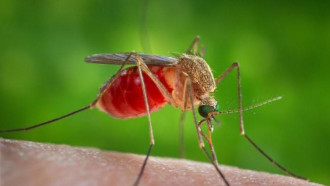Bangladeshis take plunge in world’s biggest swim lesson

Dhaka: After her eldest son Amanto became one of the 50 children to drown on an average day in Bangladesh, Jahanara Anwar was determined that his younger brother join the world’s biggest swimming lesson.
‘I’d promised to send him to a swimming centre once his exams were over but didn’t realise how important it was,’ she said, recalling the day in 2011 when Amanto, 14, went to play in a nearby canal and never came home.
‘Now there can be no doubt how important it is... I don’t want any mother to suffer the agony I’ve been through.’
Around 18,000 children drown each year in Bangladesh — a daily average of just over 49 — making it the leading cause of death among children aged one to 17.
In a country criss-crossed by deltas, plagued by floods during the monsoon season, and where around a quarter of the 160 million population live by the sea, the dangers are part of everyday life.
But few youngsters can swim, as most parents are reluctant to pay for lessons while struggling to make ends meet in one of the world’s poorest nations.
Mandatory lessons
But earlier this year, the government announced it would make it mandatory for all schoolchildren to learn to swim, making it the most ambitious mass swimming programme ever attempted.
While other countries such as Australia have made swimming lessons compulsory, the scale of Bangladesh’s plan is unrivalled — no country has ever set itself such a large target and it is expected to be several years before every youngster takes the plunge.
‘We are aiming to teach almost 40 million children aged between five and 17 years how to swim,’ Farhana Haque, a senior official in the education ministry, which is in charge of the project, told AFP.
‘I believe it is the biggest swimming programme to have ever been conducted at one time.’
Given the shortage of proper swimming centres, the government has ordered schools to use local ponds as an alternative while the UN’s children’s fund UNICEF is making giant inflatable pools available along with helping to fund or run some of the lessons.
On a chilly Sunday morning in the capital Dhaka, a group of around a dozen boys and girls were taking a dip in one of the UNICEF pools, just about able to stand in the four feet of water.
‘Before I was so scared of water. Now I feel so excited to come here,’ said 10-year-old Kobita Akhter, beaming with pride after completing a length, before paddling back to rejoin her friends at the other end.
Amy Delneuville, a UNICEF child protection specialist, said trainers had received a warm reception, including in conservative rural areas where the idea of girls in swimming costumes might have been frowned upon.
‘As there are so many water bodies in Bangladesh, drowning for children is a very serious issue here,’ she told AFP.
‘People are very happy with the programme. They know how dangerous water can be.’
As well as teaching youngsters how to swim, older teenagers are being taught how to carry out the training themselves.
Ferry disasters
Some of the deadliest drowning accidents occur when ferries ploughing Bangladesh’s vast river network, packed way beyond capacity, capsize. The distance between shores can be vast so a heavy toll is almost inevitable.
At least 78 people drowned in February when a ferry sank after colliding with a cargo vessel on the Padma river, a channel of the mighty Ganges.
Seated with her four-year-old daughter while crossing an 18-kilometre (11-mile) stretch of the Padma, Shabana Begum admitted neither can swim.
‘We are relying on the will of Allah that nothing happens to us,’ the 22-year-old said on the lower deck, with only a handful of lifebelts for dozens of passengers.
The ferry’s captain, Sharif Musharraf Hossain, said it’s a particularly dangerous stretch of water.
‘The number of people on board is not the main issue, the ferries are small and the currents in Padma are strong,’ Hossain said.
‘During calamities people get scared and start running randomly on the deck because they don’t know what to do.’
Although few are as intimidating as the Padma, there are more than 230 rivers in Bangladesh which frequently burst their banks.
Scenes of waist-high water flooding Dhaka’s streets and those of other cities are commonplace during the monsoon season from June to October.
Now that her surviving son Ananto is learning to swim, Jahanara Anwar is confident the eight-year-old will not only be able to save himself if disaster strikes but also help others.
‘I told Ananto to save any drowning person he’d come across. Nobody could save your brother, but it’s your duty to do so.’

 AFP
AFP




